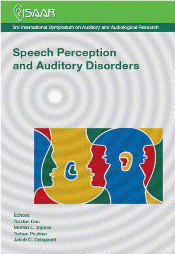Horizontal-plane localization with bilateral cochlear implants using the SAM strategy
Abstract
Sound source localization capability of cochlear implant (CI) users has been a popular research topic over the past few years, because it has both social and safety implications. While it is widely accepted that unilateral implantation does not provide enough information for this task, conditions, algorithms and their parameterization for the best performance in the binaural case are still in the focus of the research. On ISAAR 2009, we presented a simulation study revealing the theoretical limits of localization performance using the widespread ACE strategy. We also gave an example of how left-right speech processor asynchrony may influence the perceived direction. In the present paper we give an outline of a novel, auditory model based CI speech processing strategy called SAM. Furthermore, using the framework from the previous study, we show how localization performance increases when using SAM instead of ACE. We present detailed comparisons to show how factors like pulse rate, signal to noise ratio, reverberation, etc. affect horizontal-plane localization. Finally, we give a simple explanation, why, unlike other strategies, spatial perception with SAM is robust against device asynchrony.
References
Grantham, D. W., Ashmead, D. H., Ricketts, T. A., Labadie, R. F., and Haynes, D. S. (2007). “Horizontal-Plane Localization of Noise and Speech Signals by Post-lingually Deafened Adults Fitted With Bilateral Cochlear Implants,” Ear and Hearing, 28, 524–541.
Harczos, T., Werner, S., Szepannek, G., and Brandenburg, K. (2010). “Evaluation of cues for horizontal-plane localization with bilateral cochlear implants,” in Proceedings of ISAAR 2009: Binaural Processing and Spatial Hearing. 2nd International Symposium on Auditory and Audiological Research. Elsinore, Denmark. Edited by J. M. Buchholz, T. Dau, J. Christensen-Dalsgaard, and T. Poulsen. ISBN: 87-990013-2-2. (The Danavox Jubilee Foundation, Copenhagen), 37–46.
Harczos, T., Chilian, A., and Husar, P. (2011). “SAM: a novel cochlear implant speech coding strategy based on an active cochlea model,” to be published. McGovern, S. G. (2009). “Fast image method for impulse response calculations of box-shaped rooms,” Applied Acoustics, 70, 182–189.
Seeber, B. U. and Fastl, H. (2004). “Localization cues with bilateral cochlear implants,” J. Acoust. Soc. Am., 123, 1030–1042.
Zue, V., Seneff, S., and Glass, J. (1990). “Speech database development at MIT: TIMIT and beyond,” Speech Communication, 9, 351-356.
Additional Files
Published
How to Cite
Issue
Section
License
Authors who publish with this journal agree to the following terms:
a. Authors retain copyright* and grant the journal right of first publication with the work simultaneously licensed under a Creative Commons Attribution License that allows others to share the work with an acknowledgement of the work's authorship and initial publication in this journal.
b. Authors are able to enter into separate, additional contractual arrangements for the non-exclusive distribution of the journal's published version of the work (e.g., post it to an institutional repository or publish it in a book), with an acknowledgement of its initial publication in this journal.
c. Authors are permitted and encouraged to post their work online (e.g., in institutional repositories or on their website) prior to and during the submission process, as it can lead to productive exchanges, as well as earlier and greater citation of published work (See The Effect of Open Access).
*From the 2017 issue onward. The Danavox Jubilee Foundation owns the copyright of all articles published in the 1969-2015 issues. However, authors are still allowed to share the work with an acknowledgement of the work's authorship and initial publication in this journal.


